Newsletter Sign Up
Subscribe to the TripToTemples newsletter and get the latest updates straight to your inbox.

Call Support 24X7 +91-8510007751
WhatsApp No. +91-8510007751
E-mail [email protected]
Business hours 9:30am - 6:30pm

Dev Deepawali Boat Ride 0 Night / 1 Days

Kailash Mansarovar Aerial Darshan 2 Night / 3 Days

Dev Deepawali Varanasi Tour 1 Night / 2 Days

Kailash Darshan from Limi Lapcha 5 Night / 6 Days

Char Dham Yatra By Heli 5 Night / 6 Days

Muktinath Pashupatinath Package 6 Night / 7 Days

Same Day Do Dham Yatra by Heli 0 Night / 1 Days

Sri Lanka Ramayana Tour 5 Night / 6 Days


Kailash Mansarovar Yatra Packages
Come with us on a spectacular journey to Kailash a very sacred place of Hindu origins. This is true with "Trip to Temples" where you get the opportunity to travel over the tough mountains and view stunning scenery before getting to Lord Shiva’s home. We offer a range of options, including aerial darshan, Overland (traveling by bus ), or taking a helicopter. One can take a bath in the holy Mansarovar Lake, and according to the ancient legends, doing so eliminates all the sins of the past existences. We provide helpers and priests that can add lots of value to your journey. Whether you love trekking or are religious, our Kailash Yatra allows getting both – the fantastic nature views and spiritual emotions.

Kailash Mansarovar Aerial Darshan
2 Night / 3 Days
- Started Kailash Mansarovar aerial view.
- No Visa, No Permit Required.
- No Age Limit for Kailash Aerial Darshan.
- Nepalgunj(2N)

Kailash Mansarovar By Road
13 Night / 14 Days
- Cost effective & comfortable trip
- Scenic drive to Kyirong Border
- Kathmandu (2N)
- Dhunche / Syabrubesi (1N)
- Kyirong County (2N)
- Lake Mansarovar (1N)
- Darchen (1N)
- Deraapuk (1N)
- Zutulpuk (1N)
- Dongba (1N)
- Kyirong County (1N)
- Kathmandu (1N)

Kailash Mansarovar Yatra 2025 Via Lucknow
8 Night / 9 Days
- Nepalgunj (1N)
- Purang (2N)
- Mansarovar Lake (1N)
- Dirapuk (1N)
- Zuthulpuk (1N)
- Purang (1N)

Kailash Mansarovar VIP
4 Night / 5 Days
- Purang (3N)
Adi Kailash Yatra Packages
"Trip to Temples " invites you to discover a hidden treasure in the region of the Himalayas. Which is Adi Kailash, also known as Chotta Kailash or ‘ Little Kailash ,’ is still lesser known but much more serene. You will have opportunities to walk through pretty forests, valleys, and ancient temples. We offer a range of options, including aerial darshan, Overland (traveling by tempo/bus ), or taking a helicopter. Our experienced leaders ensure that you not only enjoy yourself but also experience some spirituality. You can sit quietly by clear lakes, see amazing mountain views, and feel close to God. Adi Kailash is perfect for people who want a deep, spiritual trip that's not too crowded.

Adi Kailash By Heli from Pithoragarh
- Shiva-The Lord of destruction
- Adi Kailash for some time
- Karma-cycle gets restored
- Pithoragarh
- Gunji / Nabi / Napalchu(3N)
Adi Kailash By Heli ex Kathgodam
6 Night / 7 Days
- Pithoragarh(2N)
- Gunji / Nabi / Napalchu (3N)
- Pithoragarh(1N)

Adi Kailash Helicopter Package
- Gunji/ Nabhi/ Napalchu(3N)

Adi Kailash by road From Kathgodam
7 Night / 8 Days
- Dharchula(1N)
- Gunji /Napalchu (2N)
- Nabhi /Budhi (1N)
- Didihat / Chaukori (1N)
- Bhimtal (1N)

Adi Kailash By Road From Dharchula

Adi Kailash and Om Parvat Yatra Ex Delhi
- Dharchula(2N)
- Didihat(1N)
Nepal Packages
With “Trip to Temples” you can witness the cultural heritage of Nepal. Explore a wide range of activities like hiking, mountaineering, rafting, elephant poling, and micro-light flights over the Himalayas. You can also explore temples in Kathmandu and visit the holy site in Lumbini , the birthplace of Gautam Buddha, and get mesmerized by an eye-pleasing view of Mount Everest. From Pashupatinath Temple to Swayambhunath Temple , explore every brick of these historic places in Kathmandu. We guide you through these exciting parts of Nepal and the peaceful temple areas to explore the country's cultures. While in Kathmandu, you may also engage in a wildlife safari in Chitwan National Park. So let's start our Nepal Tour where we get many great experiences.

Kathmandu City Sightseeings
1 Night / 2 Days
- Kathmandu(1N)

Nepal Thrilling Adventure Tour
- Kathmandu(2N)
- Nagarkot(1N)
- Bahrabise(1N)

Nepal Wild Nature Tour Package
5 Night / 6 Days
- Kathmandu(2)
- Chitwan(2N)

Historic Nepal Package

Young Adventure Nepal with Bungee Package
- Pokhara
- Kathmandu
- Dhulikhal(1N)
- Pokhara(2N)
Varanasi Packages
Visit Varanasi, an ancient and important Hindu city, with "Trip to Temples" . This city has an antique appearance and many traditions kept alive, it is also full of life. From Bodhgaya to Sarnath we have every package to make you feel alive. Experience night Aarti at the ghats of Ganga, small lanes with good smell and colorful shops, and imagine yourself on the banks of the river. You can arrange pooja with local priests. From boat rides at sunrise to beautiful aarti in the evening, feel the special energy of Varanasi. Let us show you this city full of faith, history, and old ways of life.

Varanasi Tour With Prayagraj
- Varanasi(2N)
- Prayagraj(2N)

Varanasi Bodh Gaya Pind Dan Package
3 Night / 4 Days
- Varanasi(1N)
- Bodh Gaya(1N).

Varanasi Bodhgaya Package

Varanasi Pilgrimage Tour With Gaya
- Varanasi (3N)

Varanasi Prayagraj Package
- Varanasi(3N)

Varanasi Pilgrimage With Ayodhya
- Ayodhya(2N)
Chardham Yatra
The Chardham Yatra is considered one of the most sacred yatra in Hindu mythology. With "Trip to Temples" you can explore the four important Hindu places: Yamunotri, Gangotri, Kedarnath, and Badrinath . We make you travel through the breathtaking Garhwal Himalayas – every place you go has a history and is spiritually significant. Right from the beginning where the Yamuna River begins to the home of Lord Shiva , each place is quite significant and stunning. We help you manage all the arrangements while you can concentrate on your preservation. You can move on with helicopters or just go by road. In our Chardham Yatra, you can experience a soulful and mindful journey.

Same Day Do Dham Yatra by Heli
0 Night / 1 Days
- BADRINATH - DEHRADUN

Char Dham Yatra By Road
11 Night / 12 Days
- Barkot (2N)
- Uttarkashi (2N)
- Guptkashi/Sitapur (2N)
- Kedarnath (1N)
- Badrinath (1N)
- Srinagar(1N)
- Haridwar (2N)

Char Dham Yatra 2024
10 Night / 11 Days
- Haridwar (1N)
- Sonprayag 2N)
- Rudraprayag (1N)

Char Dham Yatra By Heli
- Dehradun-Yamunotri-Gangotri-Kedarnath- Badrinath

Badrinath Package
- Rudraprayag (2N)

Do Dham Yatra By Heli (3N 4D)
- DEHRADUN(1N)
- KEDARNATH(1N)
- BADRINATH(1N).
We Got Featured in the Media

- Get All Details
Need More Information About Yatra 2024
Connect with us :.
Office Address :
Trip To Temples, 201, JOP Plaza Sector 18, Noida, 201301 Uttar Pradesh, India Call : +91-8510007751 E-mail : [email protected]
Quick Links :
- Terms & Conditions
- Cancellation Policy
- Privacy Policy
Tour Resources :
- Traveller Reviews
- Kailash Yatra FAQs
- Download All Important Doc
- Bank Details
- Weather At Kailash Mansarovar
- Kailash Mansarovar Yatra By Overland Weather
- Guidelines For Kailash Yatra
- Kailash Yatra Packages
Trip To Temples Packages :
- Kailash Yatra By Helicopter from Lucknow (11 Days)
- Overland Kailash Mansarovar Yatra (14 Days)
- Kailash Yatra By Helicopter (5 Days)
- Kailash Mansarovar Yatra By Helicopter from Kathmandu
- Kailash Mansarovar Yatra Via Lucknow
- Kailash Mansarovar Inner Parikrama
- Kailash Yatra Via Lhasa
- VIP Kailash Yatra Package
- Kailash Mansarovar Yatra 2025
Popular Blogs :
- About Mount Kailash
- Why Is Mount Kailash A Part Of China
- History Of Kailash Mansarovar
- Adi Kailash
- Shiva The God Of Gods
- Adi Kailash Tour Yatra Packages Blogs
- Chota Chardham Yatra: The Journey to Liberation
Popular Destination :
- Char Dham Yatra
- Adi Kailash Yatra
- Sri Lanka Tour Package
- Varanasi Tour Packages
All Credit Cards
Debit Card of All Banks
35+ Netbanking
EMI, Cash Cards
Foreign Currency Payment
© 2024 Trip To Temples. All Rights Reserved. Privacy Policy Terms & Conditions Contact Us
Design & Developed By : Divine Mantra Private Limited

Getty Images/iStockphoto
Kailasa Temple
Top choice in Maharashtra
One of India’s greatest monuments, this astonishing temple, carved from solid rock, was built by King Krishna I in AD 760 to represent Mt Kailasa (Kailash), Shiva’s Himalayan abode. To say that the assignment was daring would be an understatement. Three huge trenches were bored into the sheer cliff face, a process that entailed removing 200,000 tonnes of rock by hammer and chisel, before the temple could begin to take shape and its remarkable sculptural decoration could be added.
Covering twice the area of the Parthenon in Athens and being half as high again, Kailasa is an engineering marvel that was executed straight from the head with zero margin for error. Modern draughtspeople might have a lesson or two to learn here.
The temple houses several intricately carved panels, depicting scenes from the Ramayana, the Mahabharata and the adventures of Krishna. Also worth admiring are the immense monolithic pillars that stand in the courtyard, flanking the entrance on both sides, and the southeastern gallery that has 10 giant and fabulous panels depicting the different avatars (incarnations of a deity) of Lord Vishnu.
After you’re done with the main enclosure, bypass the hordes of snack-munching day trippers to explore the temple’s many dank, bat urine–soaked corners with their numerous forgotten carvings. Afterwards, hike the sturdier path up to the south of the complex (past the scaffolding) that takes you to the top perimeter of the ‘cave’, from where you can get a bird’s-eye view of the entire temple complex.
Suggest an edit to this attraction
Lonely Planet's must-see attractions

Ellora Cave Temples
The saga of the hammer and chisel comes full circle at the Unesco World Heritage-listed Ellora cave temples, located 30km from Aurangabad. The pinnacle of…

Bibi-qa-Maqbara
12.45 MILES
Built by Aurangzeb’s son Azam Khan in 1679 as a mausoleum for his mother Rabia-ud-Daurani, Bibi-qa-Maqbara is widely known as the poor man’s Taj. With its…

Cave 10 is the only chaitya in the Buddhist group and one of the finest in India. Its ceiling features ribs carved into the stonework; the grooves were…
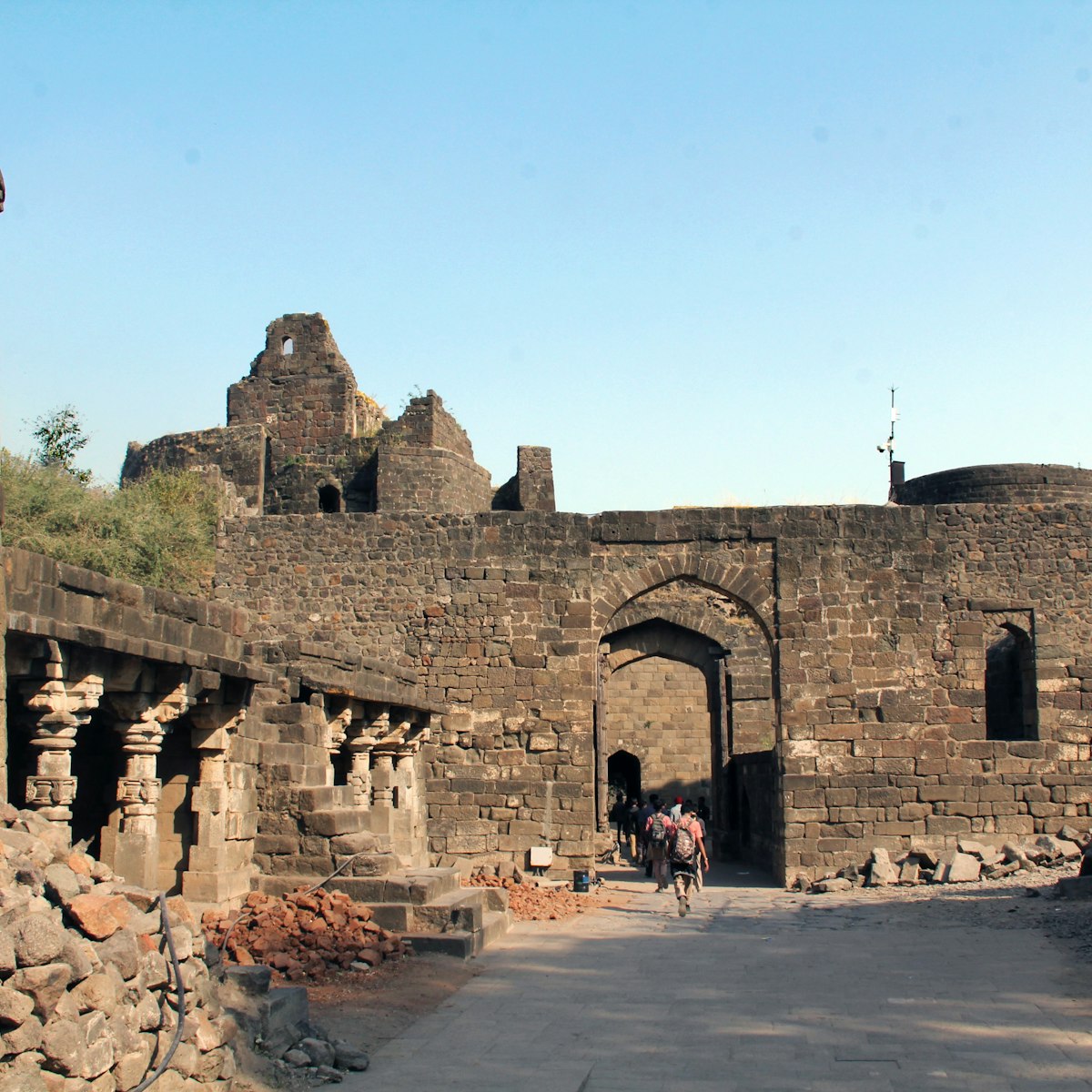
Daulatabad Fort
No trip to Aurangabad is complete without a pit stop at the ruined but truly magnificent hilltop fortress of Daulatabad, about 15km away from town en…

Buddhist Caves
Calm and contemplation infuse the 12 Buddhist caves, which stretch to the south of Kailasa. All are Buddhist viharas (monasteries) used for study and…

Hindu Caves
Drama and excitement characterise the Hindu group (Caves 13 to 29). In terms of scale, creative vision and skill of execution, these caves are in a league…

The five Jain caves, the last created at Ellora, may lack the ambitious size of the best Hindu temples, but they are exceptionally detailed, with some…

Cave 32, the Indra Sabha (Assembly Hall of Indra), is the finest of the Jain temples. Its ground-floor plan is similar to that of the Kailasa, but the…
Nearby Maharashtra attractions
1 . Cave 15
Cave 15, the Das Avatara (Ten Incarnations of Vishnu) Cave, is one of the finest at Ellora. The two-storey temple contains a mesmerising Shiva Nataraja…
2 . Ellora Cave Temples
3 . Cave 14
Cave 14, the Ravana-ki-Khai, is a Buddhist vihara converted to a temple dedicated to Shiva sometime in the 7th century.
4 . Hindu Caves
5 . Cave 13
Cave 13 is a simple Hindu cave, most likely a granary.
6 . Cave 12
Cave 12, the huge Tin Thal (Three Storey) Cave, is entered through a courtyard. The locked shrine on the top floor contains a large Buddha figure flanked…
7 . Caves 17 to 20
Caves 17 to 20 are simple monasteries.
8 . Cave 11
Cave 11, the Do Thal (Two Storey) Cave, is entered through its third basement level (undiscovered until 1876). Like Cave 12, it possibly owes its size to…
- Logout Login
- Adventure Holidays
- Weekend Getaways
- Driving Holidays
- Travel News
Top Searches
Firecracker Banned States
Black Panther Spot Places Indi
World Most Unexplored Countrie
Bandhavgarh National Park
Bucket List Destinations India
Earth Mysterious Water Bodies
Exploring Kailasa Temple, one of world's most remarkable cave temples
Times of India TIMESOFINDIA.COM / TRAVEL TRENDS , MAHARASHTRA / Created : Nov 20, 2023, 12:44 IST
You're Reading
India's Maharashtra is home to one of the world's most interesting specimens of brilliant architecture, Kailasa Temple. A megalith temple, it is one of the most stunning architectural sights that you would have ever come across an … Read more
India's Maharashtra is home to one of the world's most interesting specimens of brilliant architecture, Kailasa Temple. A megalith temple, it is one of the most stunning architectural sights that you would have ever come across and is a part of the Ellora group of temples here. Read less
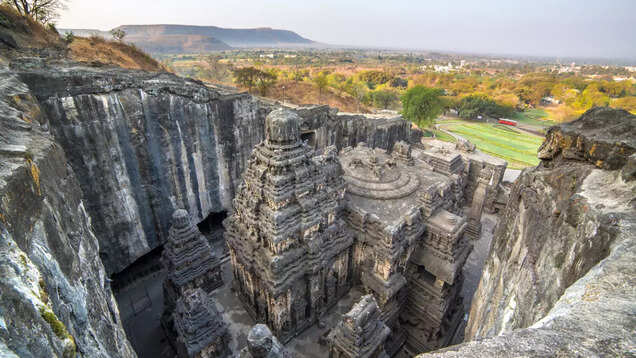
More from Travel News

What makes Kailasa Temple remarkable?
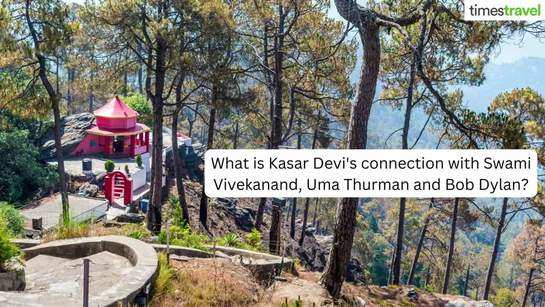
Kasar Devi's connection with Vivekanand, Uma Thurman and Bob Dylan
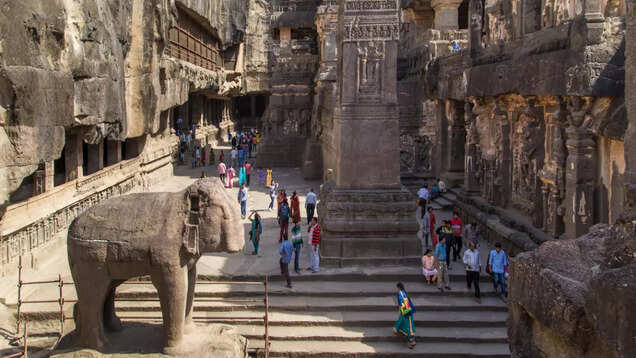
Comments (0)

Refrain from posting comments that are obscene, defamatory or inflammatory, and do not indulge in personal attacks, name calling or inciting hatred against any community. Help us delete comments that do not follow these guidelines by marking them offensive . Let's work together to keep the conversation civil.
Comments ( ) Sort: Newest UpVoted Oldest Discussed Down Voted closecomments

SIGN IN WITH
Or post without registration.

Visual Stories
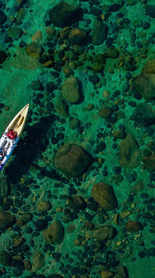
Popular Galleries
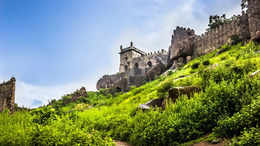

Exploring 5 Indian states without international borders TRAVEL TRENDS , INDIA

World’s 5 most forbidden places and what lies behind the ‘No Entry’ signs TRAVEL TRENDS , WORLD

6 places with unsolved mysteries that you can actually visit TRAVEL TRENDS , WORLD
Trending stories.
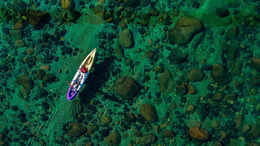
10 most beautiful Indian villages

Thailand rolls out biometric system at 6 major airports for seamless travel

5 Indian states without international borders
World’s 5 most forbidden places and what lies behind the ‘no entry’ signs.

This town in Rajasthan is made of salt!
- 1 Exploring Kailasa Temple, one of world's most remarkable cave temples
- 2 Bringing back gharials from the brink of extinction
- 3 Enchanting beauty of Tawang’s Madhuri Lake
- 4 Why is Palawan in the Philippines a must visit island?
- 5 Solang Valley and adventure are inseparable; here’s how

THE DEFINITIVE GUIDE TO DESTINATIONS, ITINERARIES, THINGS TO DO, RESTAURANTS, NIGHTLIFE and LOTS MORE!
FOLLOW US ON
Places to visit.
- Places to visit in Bangalore
- Places to visit in Mumbai
- Places to visit in Delhi
- Places to visit in Goa
- Hotels in Goa
- Hotels in Jaipur
- Hotels in Shimla
- Hotels in Mumbai
Things To do
- Things to do in Goa
- Things to do in Mumbai
- Things to do in Bangalore
- Things to do in Delhi
Travel Inspiration
- Visa on arrival for Indians
- Honeymoon Places in india
- Hill Stations in India
- Weekend getaways in Mumbai
- Weather in Delhi
- Weather in Chennai
- Weather in Bangalore
- Weather in Mumbai
Best Beaches
- Goa Beaches
- Mumbai Beaches
- Pondicherry Beaches
- Kerala Beaches
- Restaurants in Bangalore
- Restaurants in Chennai
- Restaurants in Pune
- Restaurants in Jaipur
- Hill Station near Delhi
- Winter trip to Ladakh
- Places to visit in Kerala
- Winter Honeymoon Destinations
- UK visa guide for Indians
- Winter Trip to Manali
- Vaishno Devi Yatra
- Special Train Ticket Booking
- HP inter-state Bus
- Honeymoon Destinations India
Latest News
- This village in India celebrates Diwali in silence and the reason is heartwarming
Congratulations!
You have been successfully added to the mailing list of Times of India Travel. To complete the subscription process, kindly open your inbox and click on the confirmation link which has been emailed to you.
Share with friends
Thank You for sharing! Your friend will receive the article link on email mentioned.
- (For more than one recipient, type addresses separated by commas)
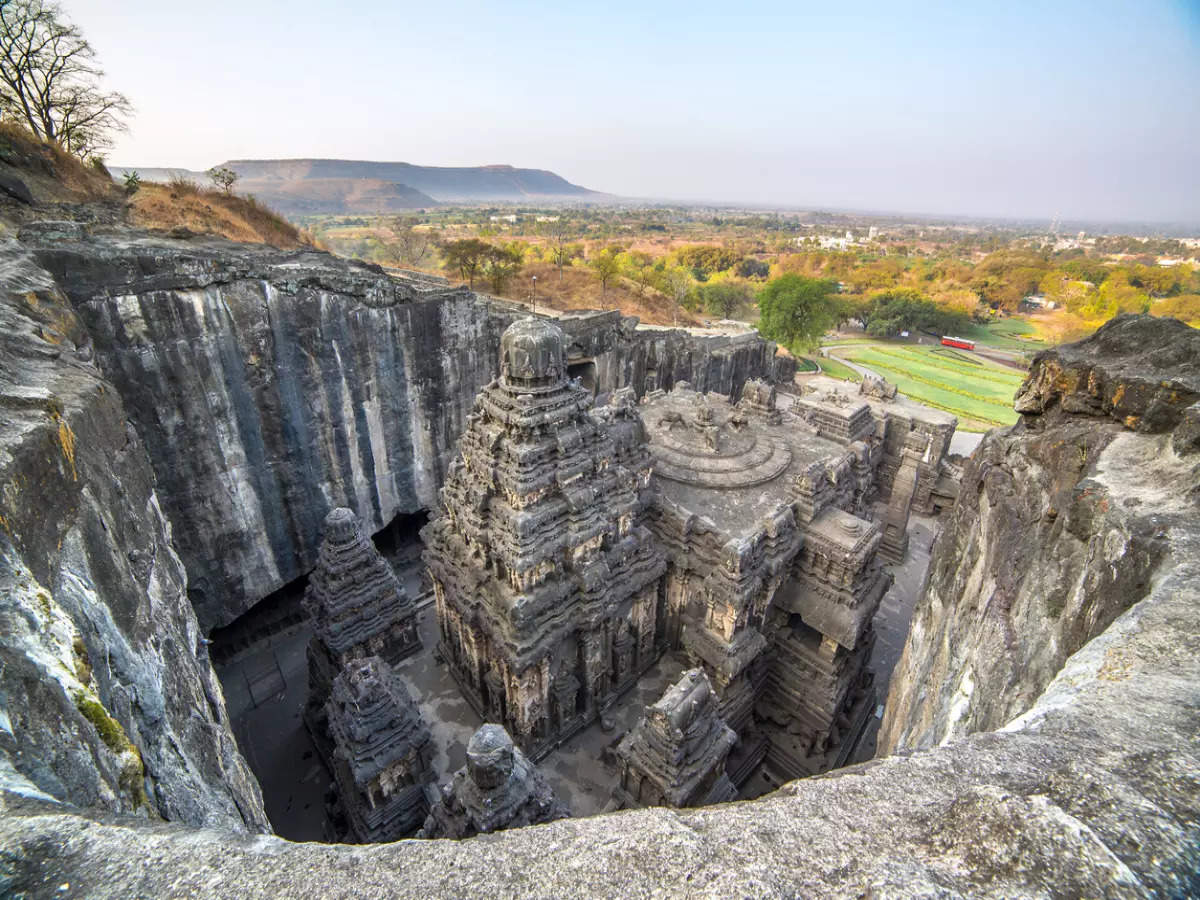
India's Maharashtra is home to one of the world's most interesting specimens of brilliant architecture, Kailasa Temple. A megalith temple, it is one of the most stunning architectural sights that you ...

- Tour Enquiry
- Sign up | Login
- My Bookings
- New User? Sign-up
- Domestic Tours
- South India
- Maharashtra
- Golden Triangle
- North India
- North East India
- International
- Maldives (Discontinued)
- All Domestic Tours
- All International Tours
- Offbeat Tours
- Domestic Cruise Tours
- Jungle Lodges by JLR
- Kabini River Lodge
- Bandipur Safari Lodge
- JLR Kings Sanctuary
- River Tern Lodge
- Kali Adventure Camp
- Hampi Heritage & Wilderness Resort
- K Gudi Wilderness Camp
- Car Rentals
- Destinations
- Tourist Places on Drive
- Driving Directions
- * Workation
- * Tour Plans
- List Property
- Ellora Caves
ELLORA CAVES TOURISM | TOURIST PLACES TO VISIT & TRAVEL GUIDE TO ELLORA
- Ellora Caves Overview
- Top 22 Places to Visit in Ellora Caves
- 23 Best Ellora Caves Tour Packages
- Top Resorts in Ellora Caves
- Best Time to Visit Ellora Caves
How to Reach Ellora Caves
- Ellora Caves Tour Plans
- Driving Directions to Ellora Caves
About Ellora Caves
Country: india | state: maharashtra, #6 of 24 places to visit in maharashtra | #41 of 100 places to visit in india, ideal trip duration: 4 hours/half day, base station: aurangabad (28 kms), nearest city to ellora caves: aurangabad (28 kms), mumbai (344 kms), best time to visit ellora caves: september to march, peak season: december to february, ellora caves weather: details not available.
At a distance of 28 km from Aurangabad, 98 km from Ajanta Caves, 104 km from Shirdi, 176 km from Nashik, 253 km from Pune, and 344 km from Mumbai, Ellora Caves are ancient historical caves located at Verul near Aurangabad in Maharashtra. Ellora is the most visited monuments of heritage in India , and among the top tourist places in Maharashtra . Locally known as 'Verul Leni', these caves are were designated a UNESCO World Heritage Site in 1983. Ellora is one of the top places to visit near Aurangabad . The caves at Ellora were carved out of the vertical face of the Charanandri hills between the 6th and 10th centuries AD. The carving work began around 550 AD, about the same time the Ajanta Caves were abandoned. Kailash Temple (Cave16), which is the most remarkable structure that can be visited as part of Ellora tour packages . The Ellora Caves were built at a time when Buddhism was declining in India and Hinduism was beginning to reassert itself. The Brahmanical movement was especially powerful under the patronage of the Chalukyas and Rashtrakutas, who oversaw most of the work at Ellora - including the magnificent Kailash Temple built in the 8th century. The last period of building activity took place in the 10th century when the local rulers switched allegiance from Shaivism to the Digambara sect of Jainism. Ellora Caves are an impressive complex of Buddhist, Hindu, and Jain cave temples. The caves have a slightly less dramatic setting than those at Ajanta, but more exquisite sculptures. The cave complex comprises 34 caves that were hewn out of solid rocks of the Charanandri hills. Of these, 12 caves belong to the Buddhist sect, 17 were Hindu and 5 were Jain Caves. Caves 1 to 12 are Buddhist monasteries, chaityas, and viharas, while caves 13 to 29 are the Hindu temples. Dating back to the 9th and 10th century, Caves 30 to 34 are the Jain shrines. The coexistence of structures from three different religions serves as a splendid visual representation of the prevalent religious tolerance of India. Ellora caves can be visited along with Aurangabad holiday packages . Kailash Temple (Cave16 is the most remarkable structure of the cave group. Shaped by hand from a single massive rock, it includes a gateway, exhibition area, square, hall, sanctum sanctorum, and a tower that bear testimony to the excellence of Dravidian art. The Kailash Temple is a stupendous piece of architecture, with interesting spatial effects and grand sculptures. It is believed to have been started by the Rashtrakuta king Krishna I (756-773). Every year Ajanta-Ellora Festival is organized in Aurangabad to pay tribute to the legendary caves of Ellora, Ajanta, and other historical monuments in the region. This grand ceremony is attended by the greatest artists of Indian art and culture. The cultural events include performances in classical and folk dancing, singing, and instrumental music. Earlier the venue for this festival was the Kailasa Temple of Ellora Caves; however, it has now been shifted to Soneri Mahal, which is a historical palace in Aurangabad. Hotel Kailas which is located just opposite the Ellora Caves is the only accommodation option nearby. It offers cottages and hostel accommodation for the budget traveler. Most tourists prefer to stay in Aurangabad and do a day trip to Ellora which is 28 km away. The nearest airport is Aurangabad, 35 km away from Ellora Caves. Aurangabad Railway station is the nearest railhead to Ellora Caves. There are public & private buses from Aurangabad to Ellora Caves. Visitors can also hire a private car from Aurangabad city. Aurangabad is well connected by bus with Pune, Mumbai, Shirdi, Nashik, Hyderabad, Bangalore, Goa, and Nagpur. The best time to visit Ellora Caves is during the months of June to February while the peak season is from October to January. These are the best time to visit Ellora Caves, as the weather is really pleasant during these months. Cave Timings: 6 AM to 6 PM on all days except Tuesdays. Entrance Fee: Rs. 10 for Indians and Rs. 250 for Foreigners.
...read more
Nearest Airport: Aurangabad - Aurangabad Airport (35 Kms)
Direct flights to aurangabad, nearest train station: aurangabad railway station (28 kms), direct trains to aurangabad, nearest bus station: ellora bus station (0 kms), direct buses to ellora caves, distance chart, distance chart & driving directions to ellora caves, top 12 places to visit in ellora caves, kailasa temple / kailasanath temple / cave 16.

#1 of 22 Places to Visit in Ellora Caves
At a distance of 300 m from Ellora Caves Bus Stop, Kailasa Temple is the largest rock-cut ancient Hindu temple in Ellora, Maharashtra. It is the prime attraction of Ellora tour packages . Dedicated to Lord Shiva, the Kailasa Temple (Cave 16) is one of the 34 Cave temples and monasteries are known collectively as the Ellora Caves. Its construction is generally attributed to the 8th-century Rashtrakuta king Krishna I based on inscriptions in Kannada. Among the top places to visit in Ellora . It is a sculpture made by cutting down rocks by sculpturing it rather than building up the temple by an architectural design. The construction was a feat of human genius - it entailed the removal of 250,000 tons of rock, took 100 years to complete, and covers an area double the size of Parthenon in Athens. It is considered one of the most remarkable cave .....
Cave 14 / Ravana Ka Khai
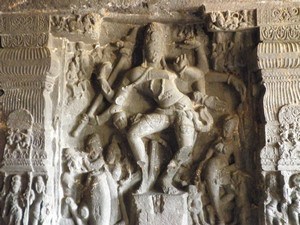
#2 of 22 Places to Visit in Ellora Caves
At a distance of 350 m from Kailasa Temple and 400 m from Ellora Caves Bus Stop, Cave 14, also known as Ravana Ka Khai or Abode of Ravana, is a Hindu cave situated beside Cave 12 in Ellora. There are 17 Hindu caves in all numbered 13 to 29, excavated out of the west face of the hill and datable from around 650 AD and 900 AD. The main examples of this group are Cave 14, Cave 15, Cave 16, Cave 21 and Cave 29. These caves occupy the center of the cave complex, grouped around either side of the famous Kailasa Temple in Ellora. These excavations immediately follow the Buddhist caves and hence the earliest Brahmanical excavations are very much similar to the Buddhist ones. The walls of the Hindu caves are covered in lively bas-reliefs depicting events from the Hindu scriptures. All of the caves are dedicated to Lord Shiva, but there are also some images of Vishnu and his various incarnations. Cave 14, a modest cave known as Ravana Ka Khai, dates from the early 7th century AD and .....
Cave 10 / Viswakarma Cave

#3 of 22 Places to Visit in Ellora Caves
At a distance of 600 m from Ellora Caves Bus Stop and 500 m from Kailasa Temple, Cave 10, also known as Viswakarma Cave is situated beside Cave 9 and is the most famous of all the Buddhist Caves in Ellora. The Viswakarma Cave is also locally known as the Sutar-ka-jhopra (Carpenter's hut). The local carpenters visit the cave frequently and worship Buddha as Viswakarma, the patron of their craft. This is the only chaitya in these series of caves, constructed around 7th century AD. This cave is one of the most magnificent caves in Ellora. The cave is entered through a gate, cut in the natural rock, which leads into a courtyard, with cells on both sides arranged in two storeys. Through the courtyard, one reaches the shrine of Lord Buddha, a typical chaityagriha. The chaitya once had a high screen wall, which is ruined at present. The shrine is 81 feet long 43 feet wide and 34 feet high. The hall is divided into a nave with side aisles by 28 octagonal pillars, each 14 feet high. At .....
Cave 32 / Indra Sabha
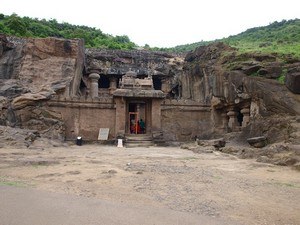
#4 of 22 Places to Visit in Ellora Caves
At a distance of 1.4 km from Kailasa Temple and 1.5 km from Ellora Caves Bus Stop, Cave 32 is a Jain cave situated to the north of Kailasa Temple in Ellora. Known as the Indra Sabha, it is the largest and finest of all Jain temples in Ellora. There are five Jain Caves at Ellora belong to the 9th and 10th centuries AD. They all belong to the Digambara sect. Jain Caves reveal specific dimensions of Jain philosophy and tradition. These caves reflect a strict sense of asceticism - they are not relatively large as compared to others, but they present exceptionally detailed art works. The most remarkable Jain shrines are the Chhota Kailash (Cave 30), the Indra Sabha (Cave 32) and the Jagannath Sabha (Cave 33). Cave 31 is an unfinished four-pillared hall and a shrine. Cave 34 is a small cave, which can be approached through an opening on the left side of Cave 33. Cave 32 is actually a series of shrines dedicated to Mahavira and other Jaina divinities aesthetically arranged in double .....
Cave 33 & Cave 34
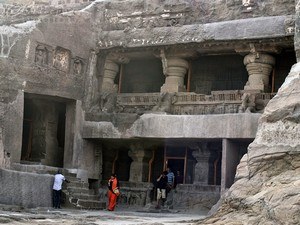
#5 of 22 Places to Visit in Ellora Caves
At a distance of 1.4 km from Kailasanath Temple and 1.5 km from Ellora Caves Bus Stop, Cave 33 is also a Jain cave situated just beside the Indra Sabha (Cave 32) in Ellora. Cave 33 is one of the popular Jain Caves in Ellora. There are five Jain Caves at Ellora belong to the 9th and 10th centuries AD. They all belong to the Digambara sect. Jain Caves reveal specific dimensions of Jain philosophy and tradition. These caves reflect a strict sense of asceticism - they are not relatively large as compared to others, but they present exceptionally detailed art works. The most remarkable Jain shrines are the Chhota Kailash (Cave 30), the Indra Sabha (Cave 32) and the Jagannath Sabha (Cave 33). Cave 31 is an unfinished four-pillared hall and a shrine. Cave 34 is a small cave, which can be approached through an opening on the left side of Cave 33. Cave 33, also known as Jagannatha Sabha, is the second largest in the Jain group of caves at Ellora. The court of the cave is much smaller .....
Cave 11 / Dho Tal
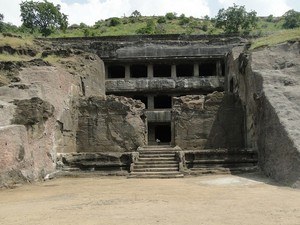
#6 of 22 Places to Visit in Ellora Caves
At a distance of 600 m from Ellora Caves Bus Stop and 500 m from Kailasa Temple, Cave 11 is situated just beside Cave 10 and is one of the 12 Buddhist Caves in Ellora. Cave 11 has two levels and is therefore known as Dho Tal or Two Floors earlier. A basement level has been discovered in 1876 AD and it brings the total floors to three. Even after this the name Do Tal remained and is called so till date. This was partially excavated in 1877 AD, and revealed a verandah 102 feet in length and 9 feet wide with two cells and a shrine in which is Buddha with Padmapani and Vajrapani as his attendants. A staircase leads to a similar verandah above, with eight square pillars in front, the back wall pierced with five doors. The first door is only the commencement of a cell. The second leads into a shrine with a colossal Buddha, his right hand on his knee and the left in his lap. In front of the throne is a small female figure holding up a water jar and to the right another sitting on .....
Cave 12 / Teen Tal
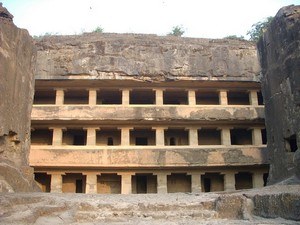
#7 of 22 Places to Visit in Ellora Caves
At a distance of 500 m from Ellora Caves Bus Stop and 400 m from Kailasa Temple, Cave 12 is situated beside Cave 11 and is one of the 12 Buddhist Caves in Ellora. Cave 12, also known as Teen Tal is the largest monastic complex at Ellora, or even in the entire Maharashtra. The complex is in three storeys, hence the name Teen Tal locally. The huge complex is entered through a huge entrance carved out of natural rock, which leads into a large courtyard. A staircase leads to the first storey which has a shrine at the rear end. There are 9 cells arranged on the side walls of the first storey. Various sculptural representations of Buddha and subsidiary deities adorn the walls. A staircase leads to the second storey which is a huge hall measuring 118 feet long and 34 feet in width. The upper floor of the Teen Tal is the most striking among the Buddhist Caves in Ellora. The hall is divided into three aisles by rows of 8 square pillars. This floor has 13 cells pierced on the end of .....
Cave 29 / Dumar Lena
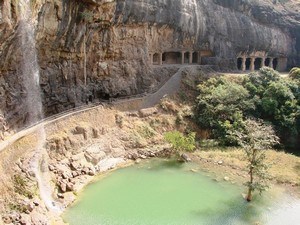
#8 of 22 Places to Visit in Ellora Caves
At a distance of 850 m from Kailasa Temple and 900 m from Ellora Caves Bus Stop, Cave 29 is also a Hindu Cave situated to the north of Kailasa Temple in Ellora. This is the earliest and last Hindu excavations to be completed at Ellora. Also Known as Dumar Lena, Cave 29 is another important excavation at Ellora by the side of Sita-Ki-Nahani, a pool created by a waterfall in the Elaganga River. Dated to late 6th century AD, Cave 29 is said to be influenced by the pattern of the Elephanta Caves near Mumbai. This cave is compared with the ones at Elephanta and Jogeswari Caves but this one is larger, finer and of a later age. This is the best preserved and largest of all the three, which were executed on the same plan. The Dumar Lena consists of an isolated shrine located within a group of halls arranged on a cruciform plan. The entire excavation extends to almost 250 feet. The shrine houses a huge linga entered through four entrances flanked by huge dwarapalas. Two large lions .....
Cave 21 / Rameshwara Cave
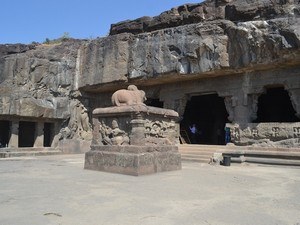
#9 of 22 Places to Visit in Ellora Caves
At a distance of 400 m from Kailasa Temple and 500 m from Ellora Caves Bus Stop, Cave 21, also known as Rameshwara Cave, is located midway between Cave 16 and 29. The Rameshwara Cave was excavated in the late 6th century AD and is supposed to be the earliest among the Hindu Caves at Ellora and also one of the noteworthy caves in Ellora. This cave is famous for the sculptural representations and its unique beauty. This cave is also dedicated to Lord Siva who was worshipped in the form of linga. A Nandi is placed just in front of the cave over a raised platform. The cave consists of a rectangular mandapa and the sanctum. The mandapa is provided with a dwarf wall which is fully sculpted on the exterior in vertical and horizontal bands. The entrance to the mandapa is flanked by sculptures of River goddesses Ganga and Yamuna. Pillars emerge at regular intervals from the dwarf wall with very beautiful and elegant salabhanjikas. The mandapa is 16 feet in height and measures 69 feet .....
Ghrushneshwar / Grishneshwar Jyotirlinga Temple
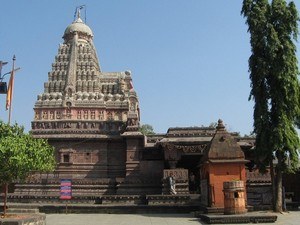
#10 of 22 Places to Visit in Ellora Caves
At a distance of 1 km from Ellora Caves, and 29 km from Aurangabad, Grishneshwar or Ghrushneshwar Jyotirlinga Temple is a famous Hindu temple located at Verul village in the Aurangabad district of Maharashtra. It is one of the famous places of pilgrimage in Maharashtra , among the must-visit places as part of Ellora tour packages . Dedicated to Lord Shiva, Grishneshwar Temple is believed to be the last or 12th Jyotirlinga on the earth. This is one of the top places to visit in Ellora , and among the prominent pilgrimage places to visit near Aurangabad . The presiding deity, in the form of Jyotirlinga, is known by several names like Kusumeswarar, Ghushmeswara, Ghrushmeswara, and Grishneswara. The Grishneshwar temple was .....

#11 of 22 Places to Visit in Ellora Caves
At a distance of 108 km from Shirdi, 181 km from Nashik, 232 km from Pune, 350 km from Mumbai, 482 km from Nagpur, and 534 km from Hyderabad, Aurangabad is a historical city and the administrative headquarters of the Aurangabad Division or Marathwada region in Maharashtra. In 2010, the Maharashtra Tourism Minister declared Aurangabad to be the tourism capital of Maharashtra. It is one of the top places to visit as part of Maharashtra tour packages . Popularly known as the City of Gates, Aurangabad is among the prominent historical places to visit near Pune . The city was founded in 1610 AD by Malik Ambar, the Prime Minister of Murtaza Nizam Shah of Ahmadnagar and his son Fateh Khan changed the original name Khadki to Fatehnagar. The areas around Aurangabad were under the control of Delhi Sultanates, Bahamani Sultans, Nizam Shahis, Mughals, and Hyderabad Nizams. With the capture ..... Distance (From Ellora Bus Station): 28 Kms Trip Duration (From Ellora Bus Station - Including Travel): Full Day .....
Devagiri / Daulatabad Fort, Near Aurangabad
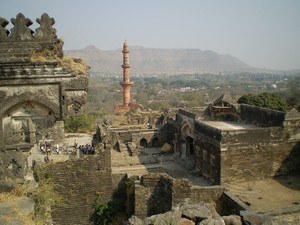
#12 of 22 Places to Visit in Ellora Caves
At a distance of 16 km from Aurangabad Railway Station, Daulatabad is an ancient hill fort situated on the way to Ellora Caves from Aurangabad in Maharashtra. It is one of the best-preserved places of heritage in Maharashtra , and also one of the best Aurangabad tourist places . The historical triangular fort of Daulatabad was built by Yadava king Bhillama V in 1187 AD. It is one of the best historical places near Pune . The city was then called 'Deogiri', meaning the hill of gods. Daulatabad or 'the abode of wealth' was the name given by Muhammad-bin-Tughlaq when he made his capital here in 1327 AD. The region and the fort passed on into the hands of Bahamani rulers under Hasan Gangu in 1347 AD and Nizam Shahis of Ahmednagar in 1499 AD. Daulatabad became the capital of the Nizam Shahi dynasty ..... Distance (From Ellora Bus Station): 13 Kms Trip Duration (From Ellora Bus Station - Including Travel): 4 Hours/Half Day .....
Top 5 Ellora Caves Packages
Ellora caves related packages, ellora caves related pages.
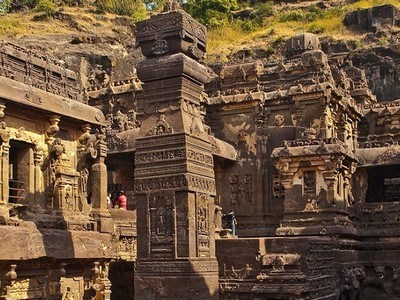
Most Popular Tourist Places in India
- Coorg Tourism
- Ooty Tourism
- Munnar Tourism
- Shimla Tourism
- Mahabaleshwar Tourism
- Chikmagalur Tourism
- Wayanad Tourism
- Pondicherry Tourism
- Goa Tourism
- Andaman Tourism
- Hampi Tourism
- Ajanta Ellora Tourism
- Lonavala Tourism
- Nainital Tourism
- Agra Tourism
- Jaipur Tourism
- Kodaikanal Tourism
- Darjeeling Tourism
- Ratnagiri Tourism
- Murudeshwar Tourism
- Varanasi Tourism
- Ayodhya Tourism
- Madurai Tourism
- Rameswaram Tourism
- Shirdi Tourism
- Dwarka Tourism
- Somnath Tourism
- Bandipur Tourism
- Nagarhole Tourism
- Thekkady Tourism
- Jim Corbett Tourism
- Kerala Tourism
- Tamilnadu Tourism
- Karnataka Tourism
- Maharashtra Tourism
- Orissa Tourism
- Sikkim Tourism
- Kashmir Tourism
Near By Places
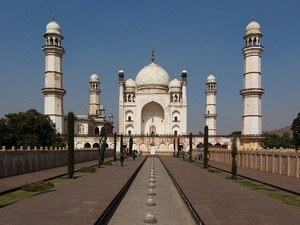
Similar Places
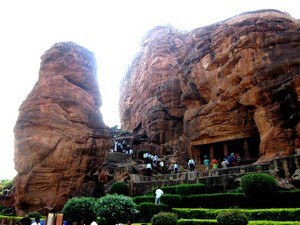
100% SECURE PAYMENTS
Domestic & International Cards Accepted

Our WhatsApp Numbers
Kerala, Tamilnadu, AP & TG Tours
Karnataka Tours
Goa, Maharashtra, Gujarat Tours
North India Tours
Rest of India
International Tours
Request Quote
Travellers #
Explore Tour Packages
Discover Affordable Tour Packages
Need Customized Tour? Request Quote
Login / sign-up.
Your Sign in was successful! Itinerary will be downloaded shortly.
Sign up with Trawell.in
Already Created Account? Login Here
Sign in with Trawell.in Account
Forgot Password?
New User? Sign Up Here
Activate Your Trawell.in Account
Your account is activated successfully. Login Here
Reset Your Trawell.in Password
Your password has been reset successfully. Login Here
Booking Policy
Kailash Temple Ellora: History, Photos, Tickets, How to Reach!
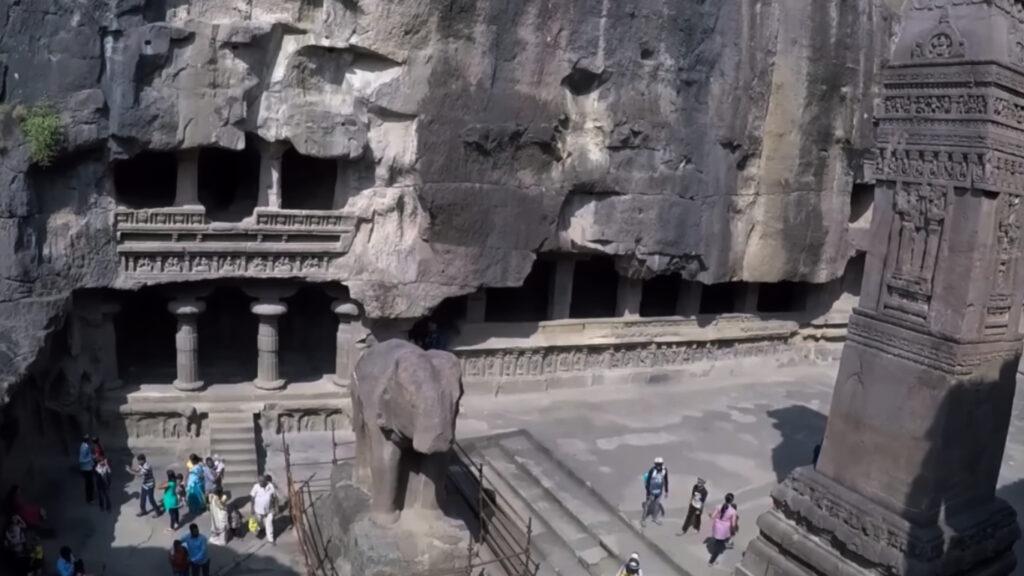
Kailasa Temple Ellora About
The Kailasa Temple at Ellora is a monolithic Hindu temple carved out of a single rock cliff face. It is considered to be one of the most remarkable cave temples in the world because of its size, architecture, and sculptural treatment.
Located in the Indian state of Maharashtra, about 15 miles northwest of the city of Aurangabad. It is one of 34 cave temples and monasteries known collectively as the Ellora Caves, which were carved out of the basalt cliffs of the Sahyadri Hills over a period of several centuries.
Built-in the 8th century CE by the Rashtrakuta king Krishna I. It is dedicated to Lord Shiva, and its design is inspired by Mount Kailash, the mythical home of the Hindu gods.
The temple complex is over 300 feet long, 175 feet wide, and 100 feet high. It is divided into three main sections: the courtyard, the main temple, and the rear section.
In Hindu mythology , Shiva has manifested himself in four places until he found peace. After doing penance every night for a thousand years he found it at Kailasha. Parvati took him there and constructed a temple for him there. He was pleased with that place. And henceforth it was called Kailasya.
Kailash Temple Ellora History
Ellora Caves were excavated by Shilaidhara, the Rashtrakuta ruler of Deccan, between 730 and 760 CE. He built the caves over three hundred years to commemorate his wars against the Pala Empire and their rule over northern India.
Kailash Temple was built by King Krishna I (ruled 756-77 CE) at a cost of twenty-five thousand gold coins. It is one of the most famous temples in India. The temple has been damaged several times by earthquakes and tourists have also vandalized some parts of it in recent years.
Kailasa Temple Ellora Photos
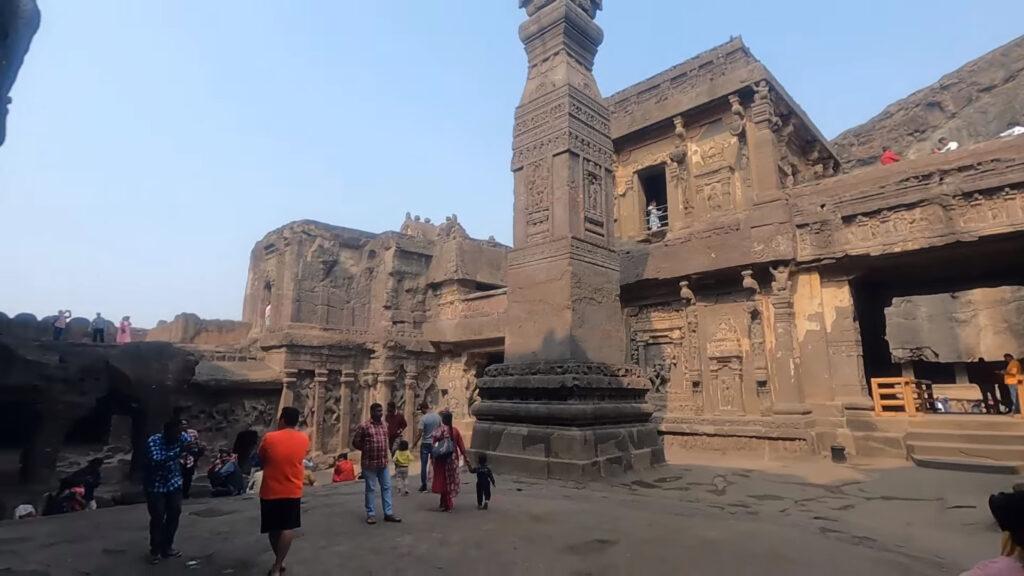
Kailasa Temple Ellora Tickets
Kailasa Temple in Ellora, you will need to buy tickets for the Ellora Caves, which is a UNESCO World Heritage Site and one of the largest rock-cut temple complexes in the world. The Kailasa Temple is the largest and most magnificent of the 34 caves in Ellora and is dedicated to Lord Shiva. It is also known as Cave 16, and is located about 300 m from the Ellora Caves Bus Stop.
Entry fees for the Ellora Caves are as follows:
- Rs. 10 per person for Indians
- Rs. 250 per person for foreigners
- Rs. 25 per camera for video photography
The guide fee is negotiable but usually ranges from Rs. 200 to Rs. 500 depending on the duration and language of the tour.
Timings for the Ellora Caves are:
- Every day of the week except Tuesday
- Morning hours: 6:00 AM to 12:00 PM
- Evening hours: 5:00 PM to 8:00 PM
The best time to visit the Ellora Caves is between October and March when the weather is pleasant and dry.
The temple is located in Cave 16 of the Ellora Caves, which is a UNESCO World Heritage Site and one of the largest rock-cut temple complexes in the world. The temple is dedicated to Lord Shiva, the Hindu god of destruction and transformation, and is modeled after his mythical abode, Mount Kailash.
Kailasa Temple is carved out of a single rock cliff, measuring about 200 feet long, 100 feet wide, and 90 feet high. It is richly decorated with sculptures, reliefs, and paintings depicting various aspects of Hindu mythology and iconography.
How to Reach Kailash Temple?
Common options to reach the Kailash temple Ellora are
- By air: The nearest airport to the Kailash Temple is the Aurangabad Airport , which is well connected to major cities of India. From the airport, take a taxi or a bus to reach the Ellora Caves, which is about 15 km away. The taxi fare may range from Rs. 500 to Rs. 700, while the bus fare may be around Rs. 50.
- By train: The nearest railway station to the Kailash Temple is the Aurangabad Railway Station , which is well connected to major cities of Maharashtra and India. From the railway station, take a taxi or a bus to reach the Ellora Caves, which is about 30 km away. The taxi fare may range from Rs. 600 to Rs. 800, while the bus fare may be around Rs. 60.
- By road: Aurangabad is well connected by road to major cities of Maharashtra and India. Drive or take a bus to reach Aurangabad and then take a taxi or a bus to reach the Ellora Caves. The road distance from Mumbai to Aurangabad is about 340 km, while from Pune it is about 260 km. The bus fare may vary depending on the type of bus and service provider, but it may range from Rs. 450 to Rs. 2,500.
Looking for a truly unique and unforgettable travel experience, then you must visit the Kailash Temple at Ellora. It is a place where you can experience the best of Indian history, culture, and adventure. Book your trip to Ellora today and start planning your adventure!
- Solo Holidays
- Inspiring Vacations
- Corporate Traveller
- Business Travel
- Desert Safari Tours
- Cool Places To Go
Best Results
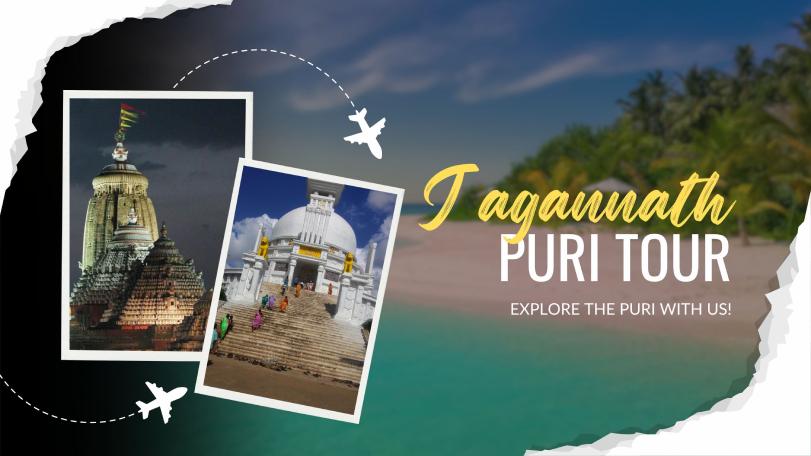
Top 500 Tourist Places to Visit

Spiti Valley Adventures: Trekking, Camping, and Road Trips

Pari Mahal: History, Architecture, Timings, Entry Fees!
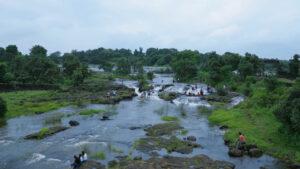
Amba Khori Waterfall Attractions, Ticket Prices & Picnics Spot Tips
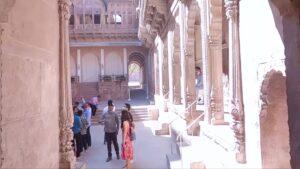
Mehrangarh Fort (Jodhpur – The Blue City): How to Reach, Timing, Entry Fee!
🗓 Best Time To Visit: June to March
⏰ Open Hours: All days of the week, 9:00 AM - 5:00 PM
🧳 Things To Do: Photography, Explore the architecture, Pilgrimage, Sightseeing
💰 Entry Fees: INR 40 for Indians, INR 600 for Foreigners, Free for children up to 15 years
🧑🤝🧑 Traveller Types: Family, Solo, Couples, History Buffs, Spiritual Seekers
🏆 Known For: Single largest monolithic rock excavation in the world, Ancient Indian rock-cut architecture, Hindu Temple dedicated to Lord Shiva
🚄 Distances: Approximately 29 km from Aurangabad railway station, 35 km from Aurangabad Airport, 230 km from Pune
📸 Photography: Allowed
♿ Accessibility: Partially wheelchair accessible
👗 Dress Code: Modest dressing is advised due to the religious significance of the site
📌 Tips: Wear comfortable shoes as the area is quite large and involves a lot of walking
Kailasa Temple Ellora: A Marvel of Rock-Cut Architecture and Art
Have you ever wondered how a magnificent temple complex can be carved out of a single rock? If yes, then you must visit the Kailasa Temple Ellora , one of the most amazing and awe-inspiring examples of rock-cut architecture in the world. Located in the Ellora Caves, a UNESCO World Heritage Site in Maharashtra, India, the Kailasa Temple is dedicated to Lord Shiva, the supreme god of Hinduism. The temple is also known as the Kailash Temple or the Kailasanatha Temple, as it is believed to represent Mount Kailash, the mythical abode of Shiva in the Himalayas. The temple was built in the 8th century CE by King Krishna I of the Rashtrakuta dynasty, who commissioned it as a symbol of his devotion and power.
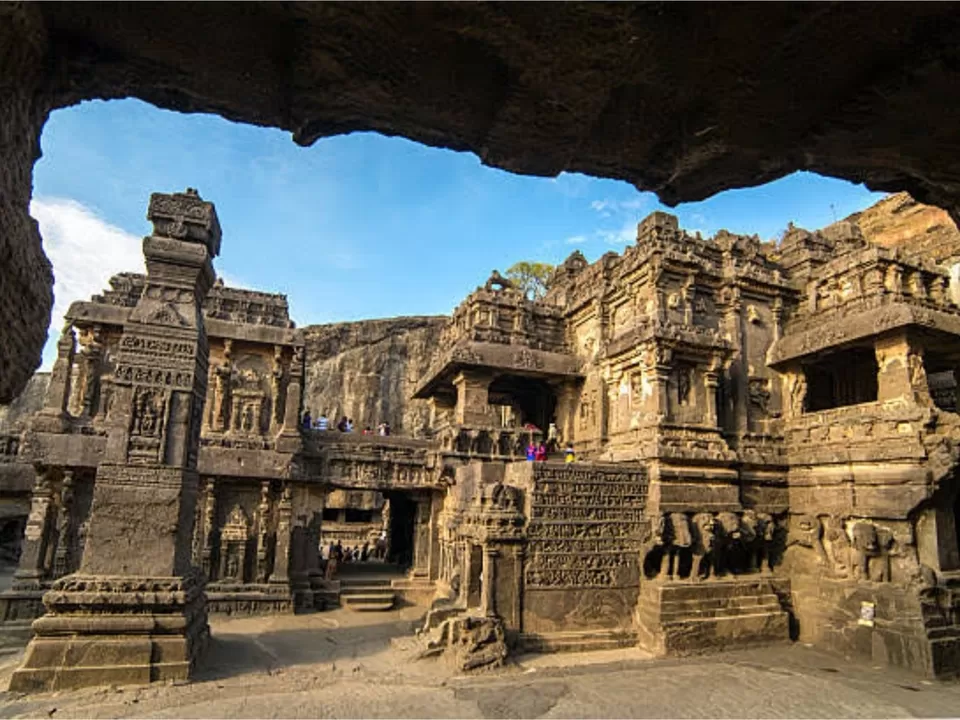
The temple is a masterpiece of art and engineering, as it showcases intricate carvings, sculptures, and reliefs that depict various aspects of Hindu mythology and culture. The temple is also shrouded in mystery and legend, as it is said to have been constructed in a single night by divine intervention.
In this article, we will explore the various features and attractions of the Kailasa Temple Ellora, and learn more about its history, architecture, carvings, legends, and cultural impact.
The Architecture of Kailasa Temple Ellora
The Kailasa Temple Ellora is a marvel of rock-cut architecture, as it was carved from a single massive basalt rock that measures about 200 feet long, 100 feet wide, and 90 feet high. The temple complex consists of four main parts: a courtyard, a gateway, a hall, and a shrine. The courtyard is surrounded by a high wall that has niches for statues of various deities. The gateway is a two-storied structure that has an arch with an image of Shiva’s bull mount Nandi. The hall is a large rectangular space that has 16 pillars and a flat roof. The hall has windows that allow natural light to enter and illuminate the interior. The shrine is a pyramidal structure that has a spire or shikhara at the top. The shrine houses the main idol of Shiva in his lingam form, which is worshipped by devotees.
The most remarkable feature of the temple’s architecture is that it was carved from top to bottom, rather than from bottom to top . This means that the sculptors had to remove more than 200,000 tons of rock to create the temple. This was a monumental task that required immense skill, precision, and planning. The sculptors had to follow a detailed blueprint that outlined the dimensions and design of the temple. They also had to use sophisticated tools and techniques to cut and shape the rock without damaging or cracking it. The temple’s architecture reflects the style and influence of various regions and periods of Indian history, such as the Pallava, Chalukya, and Rashtrakuta dynasties. The temple also incorporates elements from Buddhism and Jainism, as it is located in Ellora Caves, which has 34 caves that belong to these three religions.
Also Read: Interesting facts you must know about the Kailasa Temple
The Carvings of Kailasa Temple Ellora
The Kailasa Temple Ellora is a treasure trove of carvings, sculptures, and reliefs that depict various scenes and stories from Hindu mythology and culture. The temple has more than 1500 carvings that cover almost every inch of its walls, pillars, ceilings, and floors. Some of the most impressive and intricate carvings are:
The Dashavatara Panel: This is a long horizontal panel that runs along the lower part of the wall on both sides of the gateway. It shows the ten incarnations or avatars of Lord Vishnu, who is considered to be the preserver and protector of the universe in Hinduism. The panel depicts Vishnu’s various forms such as Matsya (fish), Kurma (turtle), Varaha (boar), Narasimha (man-lion), Vamana (dwarf), Parashurama (warrior), Rama (prince), Krishna (cowherd), Buddha (enlightened one), and Kalki (future savior).
The Ravana Shaking Mount Kailash Scene: This is a large vertical carving that occupies the entire wall behind the Nandi statue on the gateway. It shows one of the most famous episodes from the epic Ramayana, in which Ravana, the king of Lanka and the antagonist of the story, tries to lift and shake Mount Kailash to disturb Shiva’s meditation. The carving depicts Ravana’s immense strength and arrogance, as well as Shiva’s calmness and power. The carving also shows Parvati, Shiva’s consort, clinging to him in fear, and various gods, goddesses, animals, and demons watching the scene in awe or terror.
The Nandi Mandapa: This is a small pavilion that stands in front of the shrine and houses a huge statue of Nandi, the bull mount of Shiva. The statue is carved from a single rock and measures about 20 feet long and 10 feet high. The statue is adorned with ornaments and garlands, and has a serene expression on its face. The pavilion has four pillars that have carvings of Shiva’s attendants or ganas, who are depicted as mischievous and playful creatures.
The Various Gods and Goddesses: The temple has numerous statues and images of various gods and goddesses from the Hindu pantheon, such as Brahma (the creator), Vishnu (the preserver), Shiva (the destroyer), Ganesha (the elephant-headed god of wisdom and success), Kartikeya (the god of war and son of Shiva), Durga (the goddess of power and victory), Lakshmi (the goddess of wealth and prosperity), Saraswati (the goddess of learning and arts), Parvati (the goddess of love and fertility), etc. These statues and images are placed in different niches, alcoves, and pedestals around the temple, and are worshipped by devotees. They also represent the diversity and richness of Hindu culture and spirituality.
You May Love: First UNESCO Heritage Monument In India To Get Hydraulic Lift Facility
The Legends of Kailasa Temple Ellora
The Kailasa Temple Ellora is not only a monument of art and architecture, but also a source of legend and lore. The temple has several stories and myths associated with it, some of which are:
The Legend of Queen Manikavati and Kokasa: This is one of the most popular legends about the origin of the temple. According to this legend, there was once a queen named Manikavati, who was a devout follower of Shiva. She had a son named Kokasa, who was also a great devotee of Shiva. One day, Kokasa fell ill and was on the verge of death. Manikavati prayed to Shiva to save her son’s life, and vowed to build a temple for him if he granted her wish. Shiva heard her prayer and cured Kokasa. Manikavati then decided to fulfill her vow and asked her son to choose a site for the temple. Kokasa chose a hill near Ellora Caves, where he saw a vision of Shiva’s abode on Mount Kailash. Manikavati then ordered her workers to carve a temple out of the hill in the likeness of Mount Kailash. However, the workers found the task impossible, as the hill was too hard and massive to cut. Manikavati then prayed to Shiva again for help, and he sent his divine architect Vishwakarma to assist her. Vishwakarma used his magic tools and skills to carve the temple in a single night.
The Legend of Shiva and Parvati’s Wedding: This is another legend that explains the significance of the temple as a symbol of love and marriage. According to this legend, Shiva and Parvati were once married in a grand ceremony on Mount Kailash, which was attended by all the gods and goddesses. However, their wedding was interrupted by Ravana, who tried to shake Mount Kailash out of jealousy and anger. Shiva then pressed his toe on the ground, causing Ravana to be trapped under the mountain. Shiva then resumed his wedding with Parvati, while Ravana begged for mercy. Shiva finally released Ravana after he praised him with hymns. The legend says that the Kailasa Temple Ellora represents Mount Kailash during Shiva and Parvati’s wedding, and that anyone who visits the temple will be blessed with marital bliss.
The Legend of Shiva’s Abode on Mount Kailash: This is another legend that relates the temple to the mythology of Shiva. According to this legend, Shiva lives on Mount Kailash with his family and followers, where he performs his cosmic dance or tandava that creates and destroys the universe. Mount Kailash is also said to be the center of the world and the source of four sacred rivers: Ganga, Indus, Sutlej, and Brahmaputra. The legend says that the Kailasa Temple Ellora is an exact replica of Mount Kailash, and that anyone who sees it will attain salvation or moksha. The Cultural Impact of Kailasa Temple Ellora.
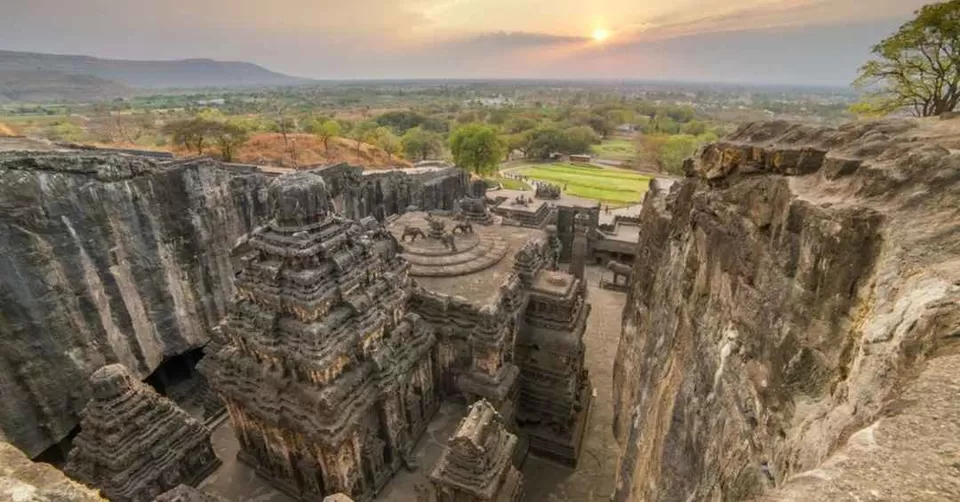
The Kailasa Temple Ellora is not only a monument of art and architecture, but also a testament of the cultural diversity and richness of India. The temple has influenced and been influenced by various aspects of Indian culture, such as art, literature, music, dance, architecture, spirituality, etc. Some examples of the cultural impact of the temple are:
- The temple has inspired many artists and writers to create works that celebrate its beauty and mystery. For instance, the famous poet Kalidasa wrote a poem called Meghaduta (The Cloud Messenger) in the 5th century CE, in which he describes the Kailasa Temple as the abode of Shiva and the destination of a cloud that carries a message from a lover to his beloved. The poem is considered to be one of the finest examples of Sanskrit literature and romantic poetry.
- The temple has also influenced the development of Indian music and dance, as it showcases various musical instruments and dance forms that are part of the Hindu tradition. For example, the temple has carvings of musicians playing instruments such as the veena (a stringed instrument), the mridangam (a drum), and the flute. The temple also has carvings of dancers performing various styles such as Bharatanatyam (a classical dance), Kathak (a storytelling dance), and Odissi (a devotional dance).
- The temple has also contributed to the preservation and promotion of Indian heritage and culture, as it has been recognized as a UNESCO World Heritage Site since 1983. The temple attracts millions of visitors every year from different parts of the world, who come to admire its beauty and learn about its history. The temple also faces some challenges and threats in terms of conservation and management, such as pollution, vandalism, and encroachment. The temple requires constant care and protection from various agencies and authorities, as well as awareness and respect from the public.
The Kailasa Temple Ellora is one of the most impressive and mysterious monuments in India, that showcases the brilliance and diversity of Indian culture and spirituality. The temple is a marvel of rock-cut architecture, that was carved from a single rock in a remarkable feat of engineering and artistry. The temple is also a treasure trove of carvings, sculptures, and reliefs that depict various scenes and stories from Hindu mythology and culture. The temple is also shrouded in legend and lore, that add to its mystery and allure. The temple is also a source of cultural impact and influence, that has inspired and been inspired by various aspects of Indian art, literature, music, dance, architecture, spirituality, etc. The temple is also a symbol of heritage and pride, that attracts millions of visitors every year from different parts of the world.
The Kailasa Temple Ellora is a must-visit destination for anyone who wants to experience the beauty and wonder of India.
Kailasa Temple Ellora Reviews

Places To Visit In Maharashtra
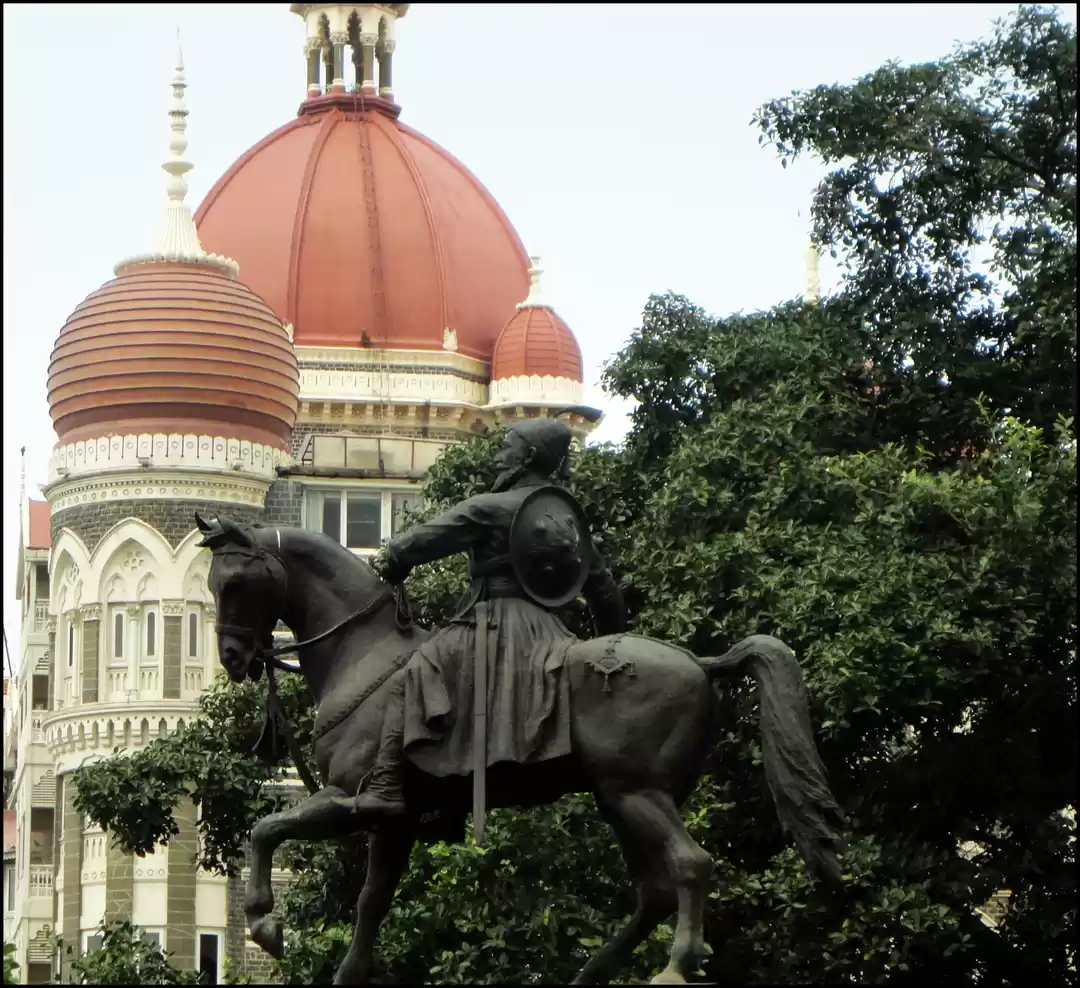
Travel Blogs for Kailasa Temple


IMAGES
VIDEO
COMMENTS
The Kailasha (IAST: Kailāśa) or Kailashanatha (IAST: Kailāśanātha) temple is the largest of the rock-cut temples at the Ellora Caves near Aurangabad district, Maharashtra of Maharashtra, India. A megalith carved from a cliff face, it is considered one of the most remarkable cave temples in the world because of its size, architecture, and sculptural treatment. It ha…
With “Trip to Temples” you can witness the cultural heritage of Nepal. Explore a wide range of activities like hiking, mountaineering, rafting, elephant poling, and micro-light flights over the Himalayas.
The Kailasa Temple (also known as Kailasanatha Temple) is one of the 34 rock-cut temples and monasteries located within the Ellora Cave complex. According to historical evidence, the construction of the temple took 20 years …
The Kailash temple of Ellora is a place where both architectural genius and the philosophy of spiritualism coexist. There is a consensus that no later Indian dynasty was able to create a …
Kailasa Temple. India, Asia. Top choice in Maharashtra. One of India’s greatest monuments, this astonishing temple, carved from solid rock, was built by King Krishna I in AD 760 to represent Mt Kailasa (Kailash), Shiva’s Himalayan abode.
India is home to the very famous Kailasa Temple that is seen as one of the world's most remarkable cave temples. It is held is high esteem across the world with its sheer size, architectural ...
Kailasanatha Temple Ellora History, Timings, Entry fees, Online Booking, Best time to reach, Contact number, Route info, Images, Tour package Cost.
Kailash Temple (Cave16 is the most remarkable structure of the cave group. Shaped by hand from a single massive rock, it includes a gateway, exhibition area, square, hall, sanctum sanctorum, and a tower that bear testimony to the …
The Kailash Temple at Ellora is a monolithic Hindu temple carved out of a single rock cliff face. About its history, see stunning photos, and find out how to get tickets and reach the temple in this informative guide.
The Kailasa Temple Ellora is a marvel of rock-cut architecture, as it was carved from a single massive basalt rock that measures about 200 feet long, 100 feet wide, and 90 feet high. The temple complex consists of four …